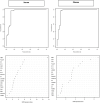Proteomic profiles for Alzheimer's disease and mild cognitive impairment among adults with Down syndrome spanning serum and plasma: An Alzheimer's Biomarker Consortium-Down Syndrome (ABC-DS) study
- PMID: 32626817
- PMCID: PMC7327223
- DOI: 10.1002/dad2.12039
Proteomic profiles for Alzheimer's disease and mild cognitive impairment among adults with Down syndrome spanning serum and plasma: An Alzheimer's Biomarker Consortium-Down Syndrome (ABC-DS) study
Abstract
Introduction: Previously generated serum and plasma proteomic profiles were examined among adults with Down syndrome (DS) to determine whether these profiles could discriminate those with mild cognitive impairment (MCI-DS) and Alzheimer's disease (DS-AD) from those cognitively stable (CS).
Methods: Data were analyzed on n = 305 (n = 225 CS; n = 44 MCI-DS; n = 36 DS-AD) enrolled in the Alzheimer's Biomarker Consortium-Down Syndrome (ABC-DS).
Results: Distinguishing MCI-DS from CS, the serum profile produced an area under the curve (AUC) = 0.95 (sensitivity [SN] = 0.91; specificity [SP] = 0.99) and an AUC = 0.98 (SN = 0.96; SP = 0.97) for plasma when using an optimized cut-off score. Distinguishing DS-AD from CS, the serum profile produced an AUC = 0.93 (SN = 0.81; SP = 0.99) and an AUC = 0.95 (SN = 0.86; SP = 1.0) for plasma when using an optimized cut-off score. AUC remained unchanged to slightly improved when age and sex were included. Eotaxin3, interleukin (IL)-10, C-reactive protein, IL-18, serum amyloid A , and FABP3 correlated fractions at r2 > = 0.90.
Discussion: Proteomic profiles showed excellent detection accuracy for MCI-DS and DS-AD.
© 2020 The Authors. Alzheimer's & Dementia: Diagnosis, Assessment & Disease Monitoring published by Wiley Periodicals, Inc. on behalf of Alzheimer's Association.
Conflict of interest statement
SEO has patents and patents pending regarding blood‐biomarkers for precision medicine in neurodegenerative diseases and served on an Advisory Board to Roche Diagnostics. No other authors have conflicts of interest to disclose.
Figures


References
-
- Rumble B, Retallack R, Hilbich C, et al. Amyloid A4 protein and its precursor in Down's syndrome and Alzheimer's disease. N Engl J Med. 1989;320:1446‐1452. - PubMed
-
- Sabbagh M, Edgin J. Clinical assessment of cognitive decline in adults with Down syndrome. Curr Alzheimer Res. 2015;13:30‐34. - PubMed
-
- Schupf N, Patel B, Silverman W, et al. Elevated plasma amyloid β‐peptide 1‐42 and onset of dementia in adults with Down syndrome. Neurosci Lett. 2001;301:199‐203. - PubMed
Grants and funding
LinkOut - more resources
Full Text Sources
Research Materials
Miscellaneous
